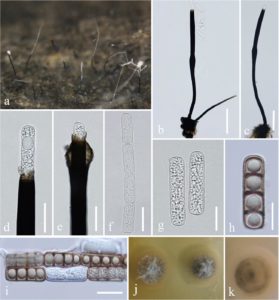Sporoschisma mirabile Berk. & Broome, Gard. Chron.: 540 (1847)
Index Fungorum number: IF 185489; Facesoffungi number: FoF 02373
Saprobic on submerged decaying wood. Sexual morph: Undetermined. Asexual morph: Colonies on the substratum superficial, effuse, gregarious, hairy, pale black. Mycelium immersed, composed of pale to dark brown hyphae. Setae scattered, capitate, with hyaline, mucilaginous substances at the swollen apex, smooth-walled, pale brown, becoming paler towards the apex, straight or flexuous, septate, 142.5 − 189.5 × 6–7 μm (x = 166×6.5 μm, n = 10). Conidiophores macronematous, mononematous, smooth, dark black, straight or slightly flexuous, solitary, each composed of a bulbous base, a cylindrical stipe and a swollen venter with a long cylindrical neck, erect, 338–432 μm long, 9–11 μm wide below venter and 13–16 μmwide above, 17.5–20.5 μm wide at venter. Conidiogenous cells monophialidic, integrated, terminal, determinate, brown. Conidia catenate, cylindrical, 31.5–40.5 × 10.5–11.5 μm (x = 36×11 μm, n = 35), aseptate and hyaline when young, becoming 3-septate, brown to dark brown at maturity, smooth.
Material examined – CHINA, Yunnan Province, saprobic on decaying wood submerged in Dulong River, May 2015, Z.L. Luo, HD 5–5–3 (HKAS 92727), living culture, KUMCC 15–0311, MFLUCC.
Notes – Sporoschisma mirabile is the type species of Sporoschisma and was introduced by Berkeley (1847). Hughes (1949) listed all collections of S. mirabile and provided measurements of conidia for each collection. A fresh isolate was obtained from submerged wood in Dulong River, during our study of lignicolous freshwater fungi, at the three parallel rivers region in northwestern Yunnan Province, China. The morphological characters of our fresh collection, especially the length and width of conidia fit perfectly the description of S. mirabile. The phylogeny analysis also provided that our strain (KUMCC 15–0311) clustered with the sexual morph of S. mirabile with high bootstrap support. Thus we identified our fresh isolate as S. mirabile, and it is the first record for China.

Fig 1. Sporoschisma mirabile (HKAS 92727) a Colonies on wood. b Conidiophore with seta. c Conidiophore. d, e Portion of phialide-producing conidia. f–i Conidia (f, g immature, h, imature). j, k Cultures on MEA, j from above, k from below. Scale bars: b, c = 100 μm, f, i = 30 μm, d, e = 20 μm, g, h = 15 μm.
